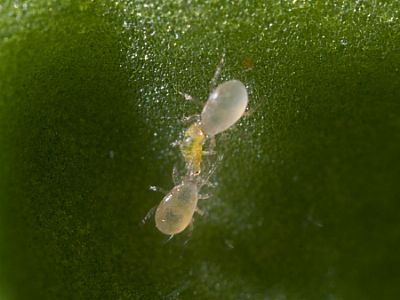SWIRSKI - MITE / Amblyseius swirskii
Predatory mites
Target
Use Swirski - Mite for biological pest control of young larvae of various thrips species and eggs and larvae of whitefly (both Trialeurodes vaporariorum and Bemisia tabaci).
Packing
-
500 ml bottle, contains 50.000 predatory mites
Each bottle with dosage cap contains predatory mites (nymphs and adults) mixed with bran
Dosage SWIRSKI - MITE
| Rate (ind./m2) | m2/ unit | Frequency | Interval (days) | Remarks | |
| Preventive | 25 | 2.000 | 1x | - | |
| Light curative | 50 | 1.000 | 1x | - |
start when thrips
or whitefly is present
|
| Heavy curative | 100 - 300 | 500 | 1x | - |
infected areas only,
always in combination
with other beneficials
|
The information given below is merely indicative. Tailored advice can be provided if information is available on the local factors that need to be taken into account, such as the crop, the climate conditions and the level of infestation. For the correct approach, please consult a specialist of our company.
How does Swirski - Mite work
Adult predatory mites search for their prey or wait for it to pass by and subsequently feed on their prey.
Application Swirski-Mite
-
Turn and shake the bottle gently before use
-
Press in the centre of the cap to open the dosage hole
-
Sprinkle material on leaves
-
Choose at least 4,000 introduction points per hectare, evenly distributed over the total surface
-
Use (Mini)-Air(o)bug if necessary for the mechanical distribution of Swirski - Mite
-
Use Swirski - Mite as a preventive method and when the first signs of a pest appear.
Precaution: application of this product can cause sensitization or allergic reactions, we therefore advise to take the necessary precautions.
Best working conditions Swirski-Mite
The predatory mite is not susceptible to diapause and therefore can also be introduced during the winter time. It is tolerant to high temperatures; a swirskii population starts to develop when the temperatures during the day regularly exceed 20-22°C.
Handling
Biological beneficials have a very short life expectancy and therefore need to be introduced into the crop as soon as possible after receipt. Failure to do so can have a negative impact on their quality. In case you do need to store Swirski - Mite, please follow the instructions below.
Storage
-
After receipt: 1-2 days
-
Storage temperature: 12-14°C/50-60°F
-
In the dark
-
Provide ventilation to prevent CO2 accumulation
Pesticides can have (in)direct effects on beneficials. Check here



 HellasSITES
HellasSITES